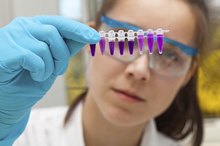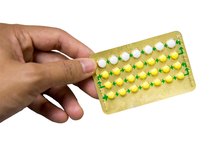Normal Range of Testosterone for a Woman
Women and men both produce a range of sex hormones. While hormones like estrogen and progesterone are most important for female reproductive function, women also produce testosterone, which contributes to fertility and other body functions. The amount of testosterone normally in a woman's body varies, primarily depending on age, menstrual status and pregnancy. Certain medical conditions can also affect a woman's testosterone level.
Testosterone Sources
In women of childbearing age, roughly 25 percent of circulating testosterone comes from the ovaries, 25 percent comes from the adrenal glands, and the remaining 50 percent arises from conversion of testosterone precursors in other body sites. Although the role of testosterone in women is not as well understood as it is in men, the hormone is known to affect ovarian function, bone strength, and is believed to contribute to sexual desire (libido).
Normal Ranges
What Does it Mean If I Have a Testosterone Level of Below 200?
Learn More
Circulating testosterone exists in a biologically-active free form and a bound form that is inactive. Depending on what test(s) your doctor orders, the laboratory will report the free testosterone level, the total testosterone level (free plus bound forms), or both. According to Mayo Medical Laboratories, the normal range for total testosterone in women is 8 to 60 nanograms per deciliter (ng/dL) 1. The range for free testosterone gradually decreases as a woman ages. Examples for specific age ranges from Mayo Medical Laboratories include:
- 20 to less than 25 years: 0.06 to 1.08 ng/dL
- 30 to less than 35 years: 0.06 to 1.03 ng/dL
- 40 to less than 45 years: 0.06 to 0.98 ng/dL
- 50 to less than 55 years: 0.06 to 0.92 ng/dL
- 60 to less than 65 years: 0.06 to 0.87 ng/dL
- 70 to less than 75 years: 0.06 to 0.82 ng/dL
- Circulating testosterone exists in a biologically-active free form and a bound form that is inactive.
- According to Mayo Medical Laboratories, the normal range for total testosterone in women is 8 to 60 nanograms per deciliter (ng/dL) 1.
Factors Affecting Testosterone in Women
Several factors can affect your testosterone level. Your age is especially influential. Your total testosterone level is usually highest in your early 20s and gradually declines as you age, although there is not a precipitous drop that accompanies menopause. Testosterone levels also vary with your menstrual cycle, being lowest during your period and peaking at mid-cycle. Additionally, testosterone levels tend to be lower in the early morning than later in the day.
Carrying excess body weight tends to increase your testosterone level, as does using hormonal contraceptives or hormone replacement therapy. Smoking may increase your testosterone level, although research on this association has yielded inconsistent results. Testosterone levels naturally increase during pregnancy but return to a normal level after delivery. Women who have had their ovaries removed have lower testosterone levels than those who have still their ovaries, even after menopause.
- Several factors can affect your testosterone level.
- Your total testosterone level is usually highest in your early 20s and gradually declines as you age, although there is not a precipitous drop that accompanies menopause.
Causes of Abnormal Results
How to Lower Progesterone & Estrogen
Learn More
Several conditions can lead to an abnormal testosterone level in women. Polycystic ovary syndrome (PCOS) is the most common cause 4. This condition is associated with excess testosterone and related hormones known collectively as androgens. Other possible causes of elevated testosterone in women include adrenal, ovarian, and pituitary tumors. Low testosterone levels occur with ovarian failure, also known as primary ovarian insufficiency.
- Several conditions can lead to an abnormal testosterone level in women.
- Low testosterone levels occur with ovarian failure, also known as primary ovarian insufficiency.
Signs and Symptoms
Excess testosterone in a woman can cause a variety of symptoms that often differ in severity, depending on the underlying cause. Common examples include:
- Increased acne
- Increased body and/or facial hair
- Thinning scalp hair
- Weight gain
- Irregular periods
A low testosterone level can also interfere with normal ovarian function and cause menstrual irregularity. However, other signs and symptoms associated with a low testosterone level in women are less well defined, largely because there is no specific level clearly associated with the development of symptoms. Symptoms purported to be associated with low testosterone levels in women include:
- Tiredness
- Decreased sex drive
- Loss of muscle mass or strength
- Depressed mood
If you are concerned about your testosterone level, talk with your doctor.
Reviewed and revised by: Tina M. St. John, M.D.
- Excess testosterone in a woman can cause a variety of symptoms that often differ in severity, depending on the underlying cause.
- Symptoms purported to be associated with low testosterone levels in women include: * Tiredness * Decreased sex drive * Loss of muscle mass or strength * Depressed mood
If you are concerned about your testosterone level, talk with your doctor.
Related Articles
References
- Mayo Medical Laboratories: Testosterone, Total, Bioavailable, and Free, Serum
- Obstetrics, Gynaecology and Women's Health; Vivienne O'Connor and Gabor Kovacs
- American Journal of Epidemiology: Testosterone Concentrations in Women Aged 25–50 Years: Associations with Lifestyle, Body Composition, and Ovarian Status
- Experimental and Clinical Endocrinology and Diabetes Reports: Differential Diagnosis of Hyperandrogenism in Women With Polycystic Ovary Syndrome
- Mosby's Diagnostic and Laboratory Test Reference, 12th Edition; Kathleen Pagana, Timothy Pagana and Theresa Pagana
- Journal of Clinical Endocrinology and Metabolism: Androgen Therapy in Women: A Reappraisal: An Endocrine Society Clinical Practice Guideline
- Stanworth RD, Jones TH. Testosterone for the aging male; current evidence and recommended practice. Clin Interv Aging. 2008;3(1):25–44. doi:10.2147/cia.s190
- McBride JA, Carson CC 3rd, Coward RM. Testosterone deficiency in the aging male. Ther Adv Urol. 2016;8(1):47–60. doi:10.1177/1756287215612961
- Kumar P, Kumar N, Thakur DS, Patidar A. Male hypogonadism: Symptoms and treatment. J Adv Pharm Technol Res. 2010;1(3):297–301. doi:10.4103/0110-5558.72420
- Johnson JM, Nachtigall LB, Stern TA. The effect of testosterone levels on mood in men: a review. Psychosomatics. 2013;54(6):509-14.
- Rajfer J. Relationship between testosterone and erectile dysfunction. Rev Urol. 2000;2(2):122–128.
- Barrett-Connor E, Dam TT, Stone K, et al. The association of testosterone levels with overall sleep quality, sleep architecture, and sleep-disordered breathing. J Clin Endocrinol Metab. 2008;93(7):2602–2609. doi:10.1210/jc.2007-2622
- Beauchet O. Testosterone and cognitive function: current clinical evidence of a relationship. Eur J Endocrinol. 2006;155(6):773-81.
- Golds G, Houdek D, Arnason T. Male Hypogonadism and Osteoporosis: The Effects, Clinical Consequences, and Treatment of Testosterone Deficiency in Bone Health. Int J Endocrinol. 2017;2017:4602129. doi:10.1155/2017/4602129
- Grossmann M, Thomas MC, Panagiotopoulos S, et al. Low testosterone levels are common and associated with insulin resistance in men with diabetes. J Clin Endocrinol Metab. 2008;93(5):1834-40.
- Cai Z, Xi H, Pan Y, et al. Effect of testosterone deficiency on cholesterol metabolism in pigs fed a high-fat and high-cholesterol diet. Lipids Health Dis. 2015;14:18. Published 2015 Mar 7. doi:10.1186/s12944-015-0014-5
- Ferrucci L, Maggio M, Bandinelli S, et al. Low testosterone levels and the risk of anemia in older men and women. Arch Intern Med. 2006;166(13):1380–1388. doi:10.1001/archinte.166.13.1380
- Nassar GN, Leslie SW. Physiology, Testosterone. [Updated 2018 Oct 27]. In: StatPearls [Internet]. Treasure Island (FL): StatPearls Publishing; 2019 Jan-.
- Rivas AM, Mulkey Z, Lado-Abeal J, Yarbrough S. Diagnosing and managing low serum testosterone. Proc (Bayl Univ Med Cent). 2014;27(4):321–324. doi:10.1080/08998280.2014.11929145
- Kanakis GA, Nieschlag E. Klinefelter syndrome: more than hypogonadism. Metab Clin Exp. 2018;86:135-144.
- Sizar O, Schwartz J. Hypogonadism. [Updated 2019 Jun 4]. In: StatPearls [Internet]. Treasure Island (FL): StatPearls Publishing; 2019 Jan-.
- Nahata L, Yu RN, Bhasin S, Cohen LE. Management of testosterone therapy in adolescents and young men with hypogonadism: are we following adult clinical practice guidelines?. J Pediatr Endocrinol Metab. 2015;28(5-6):635-40.
- McBride JA, Carson CC, Coward RM. Diagnosis and management of testosterone deficiency. Asian J Androl. 2015;17(2):177–186. doi:10.4103/1008-682X.143317
- Crawford ED, Poage W, Nyhuis A, et al. Measurement of testosterone: how important is a morning blood draw?. Curr Med Res Opin. 2015;31(10):1911-4.
- Wersinger SR, Haisenleder DJ, Lubahn DB, Rissman EF. Steroid feedback on gonadotropin release and pituitary gonadotropin subunit mRNA in mice lacking a functional estrogen receptor alpha. Endocrine. 1999;11(2):137-43.
- Rhoden EL, Estrada C, Levine L, Morgentaler A. The value of pituitary magnetic resonance imaging in men with hypogonadism. J Urol. 2003;170(3):795-8.
- Snyder PJ, Kopperdahl DL, Stephens-Shields AJ, et al. Effect of Testosterone Treatment on Volumetric Bone Density and Strength in Older Men With Low Testosterone: A Controlled Clinical Trial [published correction appears in JAMA Intern Med. 2017 Apr 1;177(4):600] [published correction appears in JAMA Intern Med. 2019 Mar 1;179(3):457]. JAMA Intern Med. 2017;177(4):471–479. doi:10.1001/jamainternmed.2016.9539
- Huo S, Scialli AR, McGarvey S, et al. Treatment of Men for "Low Testosterone": A Systematic Review. PLoS One. 2016;11(9):e0162480. Published 2016 Sep 21. doi:10.1371/journal.pone.0162480
- Armamento-Villareal R, Aguirre LE, Qualls C, Villareal DT. Effect of Lifestyle Intervention on the Hormonal Profile of Frail, Obese Older Men. J Nutr Health Aging. 2016;20(3):334–340. doi:10.1007/s12603-016-0698-x
- American Urological Association. Evaluation and management of testosterone deficiency.
- Grech A, Breck J, Heidelbaugh J. Adverse effects of testosterone replacement therapy: an update on the evidence and controversy. Ther Adv Drug Saf. 2014;5(5):190–200. doi:10.1177/2042098614548680
- American Urological Association, Evaluation and Management of Testosterone Deficiency.
- Fillo J, Breza J Jr, Ondrusova M, Luha J, Ondrus D, Dubravicky J, et al. Results of long term testosterone replacement therapy in men with abdominal obesity, erectile dysfunction and testosterone deficiency. Bratisl Lek Listy. 2018;119(9):577-580. doi:10.4149/BLL_2018_061
- Tremellen K, McPhee N, Pearce K, Benson S, Schedlowski M, Engler H. Endotoxin-initiated inflammation reduces testosterone production in men of reproductive age. Am J Physiol Endocrinol Metab. 2018 Mar 1;314(3):E206-E213. doi:10.1152/ajpendo.00279.2017. Epub 2017 Nov 28.
Resources
Writer Bio
Amy Dixon has been writing on a local level since 2005, focusing on health and fitness. She is an ACSM Registered Clinical Exercise Physiologist and holds a Master of Science degree in exercise and wellness promotion from Slippery Rock University of Pennsylvania.








